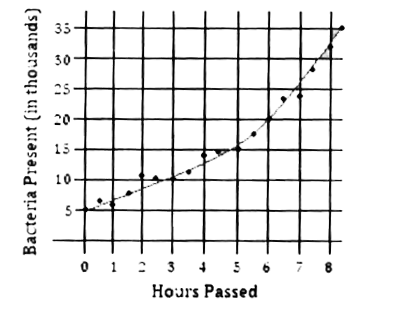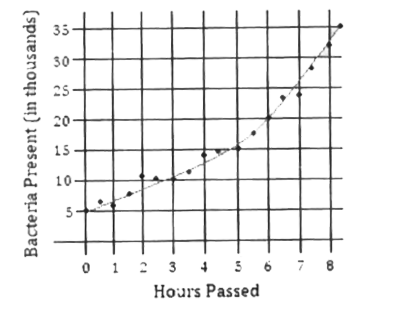A microbiologist is studying the effects of a new antibiotic on a culture of 20,000 bacteria. When the antibiotic is added to the culture, the number of bacteria is reduced by half every. What king of function best models the number of bacteria remaining in the culture after the antibiotic is added?
A linear function
A quadratic function
A polynomial function
An exponential function
The correct Answer is:D
Step by step video, text & image solution for A microbiologist is studying the effects of a new antibiotic on a culture of 20,000 bacteria. When the antibiotic is added to the culture, the number of bacteria is reduced by half every. What king of function best models the number of bacteria remaining in the culture after the antibiotic is added? by Maths experts to help you in doubts & scoring excellent marks in Class 10 exams.
Topper's Solved these Questions
Similar Questions
A biologist places a colony consisting of 5000 bacteria into a petri dish. After the intial placement of the bacteria at time t = 0, the biologist measures and estimates the number of bacteria present every half hour. This data was then fitted by an exponential curve of the form y=c.2kt where c and k are constants, t is measured in hours, and y is measured in thousands of bacteria. The scatterplot together with the exponential curve are shown below.

According to the scatterplot, the biologist'smeasurements indicate that the number of bacteria present quadrupled in 6 hours, and the exponential curve passes through the corresponding data point at time t = 6. The exponential function also agrees with the initial number of bacteria. Compute ck.View SolutionA biologist places a colony consisting of 5000 bacteria into a petri dish. After the intial placement of the bacteria at time t = 0, the biologist measures and estimates the number of bacteria present every half hour. This data was then fitted by an exponential curve of the form y=c.2kt where c and k are constants, t is measured in hours, and y is measured in thousands of bacteria. The scatterplot together with the exponential curve are shown below.

Suppose that the data was fitted with a quadratic function of the form t2+bt+c instead of an exponential function. Assume that the quadratic funtion agrees with the scatterplot at times t = 0 and t = 6. What is the t - coordinate of the vertex of the graph of the quadratic function?View Solution
Knowledge Check
- Question 1 - Select One
The population of a bacteria culture doubles in number every 12 minutes. The ratio of the number of bacteria at the end of 1 hour to the number of bacteria at the beginning of that hour is
A64:1B60:1C32:1D16:1 - Question 2 - Select One
The number of bacteria colonies h hours after the beginning of an experiment is given by the function C(h)=3h−2h+20. What does the number 20 represent in the function?
AThe final rate of growth, in colonies per hour.BThe initial rate of growth, in colonies per hourCOne less than the initial number of bacteria coloniesDOne more than the final number of bacteria colonies. - Question 3 - Select One
As part of a laboratory experiment, the number of times a light id flashed on a certain culture of bacteria is reduced 20 percent each day. If the light flashed 704 times on the fourth day of the experiment, then the number of times it flashed on the first day is closest to
A880B1,217C1,267D1,375
The number of bacteria in a certain culture doubles every hour. If there were 30 bacteria present in the culture originally, how many bacteria will be present at the end of 2nd hour, 4th hour and nth hour?
View SolutionThe number of bacteria in a certain culture doubles every hour. If there were 30 bacteria present in the culture originally, how many bacteria will be present at the end of 2nd hour, 4th hour and nth hour?
View SolutionIn a certain culture the number of bacteria at any instant increases at a rate proportional to the cube root of the number present at that instant. If the number becomes 8 times in 3 hours, when will the number be 64 times?
View SolutionThe rate of increase in the number of bacteria in a certain bacteria culture is proportional to the number present. Given the number triples in 5 hrs., find how many bacteria will be present after 10 hours. Also find the time necessary for the number of bacteria to be 10 times the number of initial present. [Given loge3=1.0986, e2.1972=9 ]
View SolutionThe number of square units, A, in the area covered by a bacteria culture is increasing at a rate of 20% every 7 days. If the bacteria culture initially covers an area of 10 square centimeters, which equation can be used to find the number of square units in the area covered by the bacteria culture after d days?
View Solution

